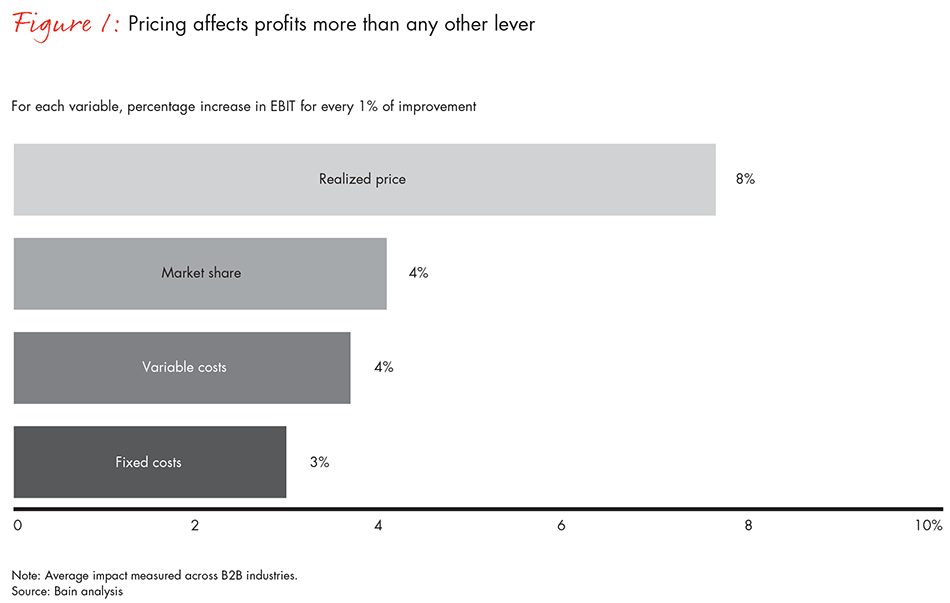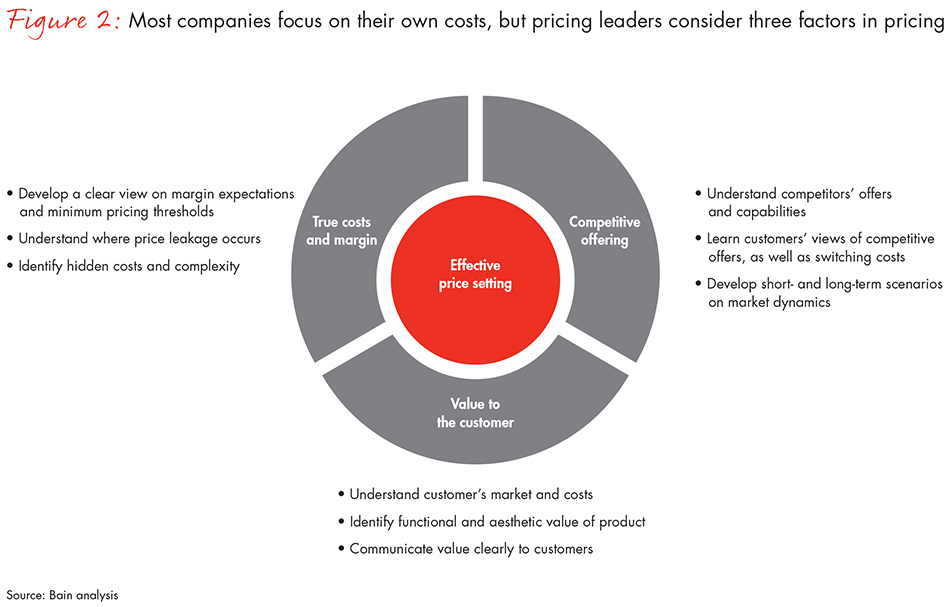論説

Why is pricing such an underdeveloped opportunity in chemicals? Companies that dedicate enormous resources to reducing costs or selling greater volumes give pricing far less attention than it deserves. Some executives think they cannot control pricing because they sell through partners or cannot control price leakage within their own salesforce. Many see chemicals as a commoditized market and believe they have to accept the price the market gives them. Others view pricing as a one-time exercise, a box to be ticked. "We sorted out pricing a few years ago," they say.
However, this passive approach is costly because these companies are foregoing a huge upside opportunity (see Figure 1). Unrealized prices are one of the biggest opportunities available to companies in the chemicals industry, but most need a new perspective before they can set out to improve their pricing capabilities. The best exponents of pricing recognize the potential at hand, and they are continually trying to find ways to do better.


Pricing is largely about starting with the right mindset and developing the right skills in-house to capture the unrealized price. Customers, even when they buy so-called commodities, take other things into account: their relationship with the supplier, how reliable the seller is and the value-added services they provide. Sometimes customers buy from a particular company just so that they can work with certain technical experts who can teach them ways to improve their business.
Most chemical companies can build better pricing capabilities within 12 to 18 months, with some benefits accruing within one or two quarters. But it requires a focused effort with ongoing support from senior leadership. The first step is understanding their profitability and how their actual price differs from the one they set. Once they start working through all of the aspects of pricing—understanding the customer value, preventing price leakage, responding to disruptive competitors—companies begin to develop better pricing capabilities, putting them in a position to earn a more consistent premium and setting them on a course of continuous improvement. In our experience, chemical companies that master this can add 200 to 300 basis points to their margin over the same period.
Pricing is more important than ever
Three trends make pricing even more critical today for chemical companies than it was just a few years ago. First, purchasing departments have become more aggressive and sophisticated, and in many cases, they expand the spending categories that they closely manage, often including the smaller-volume specialty chemical categories. Also, it’s relatively easy for buyers to get price information through an Internet search, even in traditionally niche areas, which can knock a supplier out of consideration before it can even meet potential customers. Innovative digital competitors take advantage of this behavior to disrupt traditional pricing norms. Finally, pricing is critical during a time of energy and feedstock price volatility because of the need to maintain stable margins amid such uncertainty. (For more on this, read "Responding to Oil Price Volatility in the Chemical Industry.")
Understandably, many chemical companies are focused on other priorities, including improving their products, increasing operational efficiency or selling out their production inventory. Even the companies that try to improve pricing often fail to do so in a sustained way. Some invest in new pricing tools or projects for a quarter or a year but then lose focus due to different priorities. Others simply fail to make pricing a long-term priority for their commercial organization and decide not to resource it appropriately. Still others have the ambition but fail to either build support across the commercial organization (marketing, sales and technical) or create the right incentives to encourage ongoing behaviors and accountability.
As companies begin a more determined approach, they need to prioritize carefully. If short-term results are the goal, they can move quickly by identifying pockets of underpriced product and taking a test-and-learn approach to adjust prices. Those that are more interested in building long-term capabilities define the end state, then choose the right tools and build discipline from the ground up. Both approaches can improve the bottom line.
Whatever the goal, any effort to improve pricing has to address the two main aspects of pricing: price setting and price getting.
- Price setting includes structuring and defining the target prices for each customer product or service for each market segment—that is, determining the list, net and final prices the company wants to realize, as well as the types of discounts it will use to achieve those price points.
- Price getting requires managing the difference between the price you want and the price you get. To succeed here, companies must develop capabilities to offer the right discounts and put tools in place to control limits. To ensure a sustainable pricing program, companies need to put in place the processes, tools and accountability measures to make sure all this happens naturally across the organization.
Setting your price
Three things are important for setting prices effectively: understanding your true costs and margins, understanding the real value of your product to customers, and getting a clear picture of the competitive environment (see Figure 2).


True costs and margins. Most chemical companies have a clear understanding of their fixed costs. By forecasting their production volumes, they can determine the average cost for what they produce and get a general idea of what they need to charge in order to deliver steady returns. However, when volumes differ widely from forecasts, some companies struggle to adapt their pricing regimes.
Leaders develop a more dynamic perspective on costs by asset and by customer so that they can adjust their prices to reflect changes over time. An adhesives company identified hidden costs not reflected in standard financial reporting (such as custom packaging and palletization, and higher technical service levels and credit terms) and adjusted their prices to make up for it.
The product’s value to customers. Chemical companies develop a better understanding of their product’s value by identifying the uses of the product, especially those that are critical to customers and so may be more highly valued. This allows them to set price floors that vary from one market or application to another.
Leaders go further, creating a more detailed view of the functional or aesthetic impact that their product has on the customer’s product or production process and how that compares to competitive offerings. They understand customers’ margin profiles and the factors contributing to success, and they incorporate this information into their pricing approach. Finally, a sales team that can communicate this value in a clear and compelling way is the critical step to getting their price.
One polymer company developed a new grade that could be extruded at higher speeds. It was able to quantify the benefit to its customers—and in doing so, recognized that the proposition was worth disproportionately more to one specific customer segment and also that the value varied with the underlying market. These insights led the company to change its entire selling approach—including pricing.
Competitive offers. Closely related companies need to develop a comprehensive perspective on the competitive landscape. Most have databases that capture and aggregate competitive quotes from customers along with anecdotes and other details on market trends.
Leaders also invest time understanding their main competitors’ capabilities and offers to get a picture of their true costs and performance. They learn what customers think about the competition, especially compared with their own products and services. They also monitor market volumes so that they can price dynamically, and they understand how their competitors’ vertical integration affects their pricing schemes. Finally, true excellence in this area requires scenario planning or the application of game theory to determine how to respond to pricing moves by competitors. For example, one oilfield chemical company was able to learn more about its comparative cost advantages in some countries and the high service levels demanded by important customers. It used those insights to identify strategic locations where it could place product ahead of sales, which helped it win more business and realize its price goals.
Getting your price
Table stakes for getting your price include building and implementing the right capabilities, processes, and tools to manage pricing over the long term while monitoring prices and margins over time to ensure you are holding steady against variable input costs.
Leaders go further.
- They make sure they have well-documented roles and processes, and well-defined pricing decision rights along with business rules to manage exceptions.
- Pricing specialists focus full time on setting and getting prices, often with a particular expertise in a region or business line, rather than at the center of a global organization. This expertise may extend to a comprehensive understanding of customers’ costs, including shipping, favored terms, rebates and other hidden costs.
- They involve the sales team early, making sure they understand the economics of price leakage and profitability, and their options within that structure. Sales incentive programs motivate the salesforce on the same metrics that measure company growth and profitability.
- They also invest in pricing tools that allow information to be aggregated and displayed in a user-friendly way. These can be very sophisticated tools that communicate closely with SAP and Salesforce (such as Vendavo) or one of the many cloud-based tools on the market that can be much quicker and easier to get up and running (such as KiniMetrix).
As pricing programs take root, leaders measure their success by setting up mechanisms that tell them whether they are capturing the prices they intend and where to intervene if they are not. To do this, they need to see where price leakage occurs so that they can take corrective action—capabilities provided by most pricing tools, assuming that teams know how to use them. Leading companies also set regular check-ins with commercial leadership to review progress over time and deal with the inevitable outliers and exceptions. Typically, these are monthly scans that take an in-depth look at several product categories, reviewing the entire line over the course of a year.
No program to improve pricing will succeed without ongoing support from top management. And while it’s natural that any change program will have promoters and detractors at the outset, it will become important for management to bring the team together behind the vision and reinforce critical pricing behavior with role modeling and the right incentives.
Executives should think about three other traits of a pricing program before they begin.
- Sequence the program. Not everything needs to happen at once. Prioritization will be essential, not only to direct focus but also to draw lessons in early stages that can be applied throughout.
- Focus on early wins. As with any new initiative, putting a premium on measurable results early can improve the case for change. Momentum builds as detractors see the benefits of new programs.
- Make it tangible and practical. None of this will work unless the salesforce buys in and changes behavior. Most companies will require a significant investment in training, tools and new processes to ensure a successful rollout and ongoing change.
David Burns and Jason McLinn are partners with Bain & Company in Chicago. Mark Porter is a partner in Bain’s London office. All three work with Bain’s Global Chemicals practice, which Mark leads.